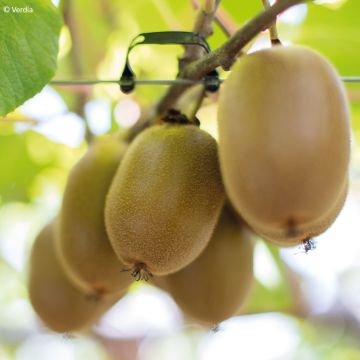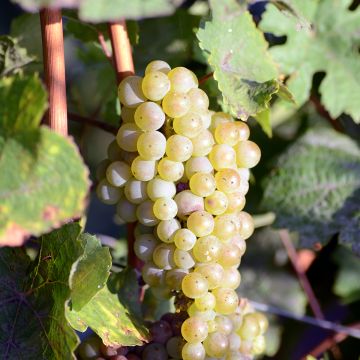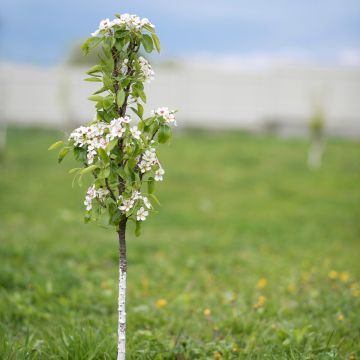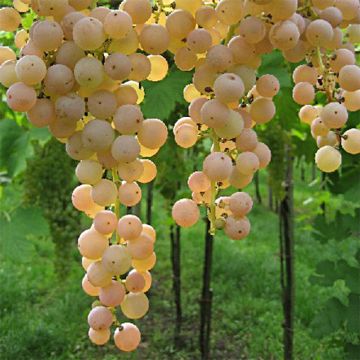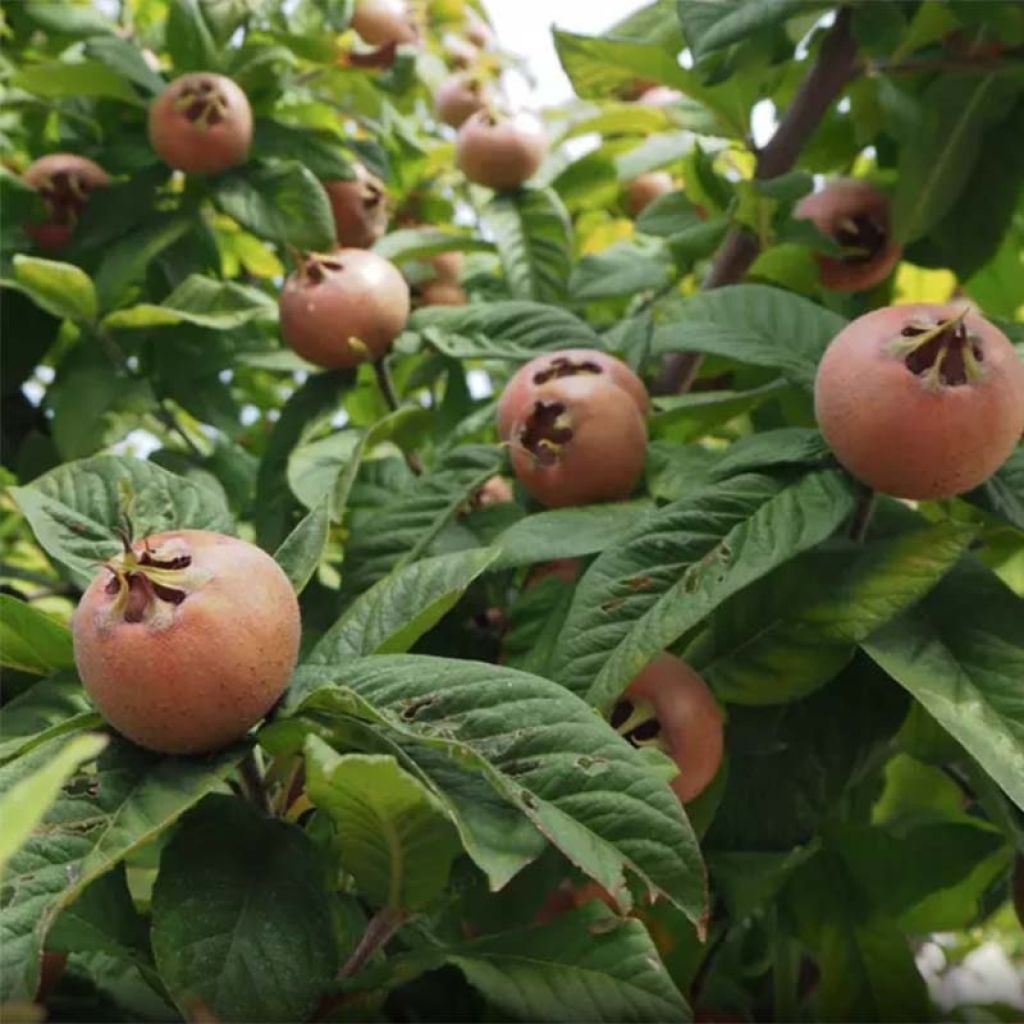

Neflier Géant d'Evreinoff Bio en racines nues, forme scion
Mespilus germanica Monstrueuse d'Evreinoff - Common Medlar
Mespilus germanica Monstrueuse d'Evreïnoff
Common Medlar
Special offer!
Receive a €20 voucher for any order over €90 (excluding delivery costs, credit notes, and plastic-free options)!
1- Add your favorite plants to your cart.
2- Once you have reached €90, confirm your order (you can even choose the delivery date!).
3- As soon as your order is shipped, you will receive an email containing your voucher code, valid for 3 months (90 days).
Your voucher is unique and can only be used once, for any order with a minimum value of €20, excluding delivery costs.
Can be combined with other current offers, non-divisible and non-refundable.
Why not try an alternative variety in stock?
View all →This plant carries a 6 months recovery warranty
More information
We guarantee the quality of our plants for a full growing cycle, and will replace at our expense any plant that fails to recover under normal climatic and planting conditions.
Description
The 'Monstrueuse d'Evreinoff' Bio Medlar is a rare and ancient variety of medlar from Germany that stands out for its vigour, precocity, and the size of its fruits. This large bush is also very ornamental with well-structured branches, large leaves, autumn colours, almost red branches, and large white flowers, even if they are ephemeral in spring. Plants from Organic Agriculture.
It blooms in April, then produces very large round and flattened medlars, measuring over 5cm (2in) in diameter and weighing over 70 grams. They are brown to light grey in colour, taking on a bright red tint in the sun, covered with lenticels. Their melting flesh is brown to pinkish, slightly fibrous, and is consumed when over-ripe. Their flavour is pleasant, well balanced between sweet and slightly acidic, sometimes almost liqueur-like. Harvesting takes place from mid-October, even in the absence of frost. The harvest is very abundant; the tree produces several hundred fruits, and the production is regular from one year to the next. The fruiting is early, but does not last long on the tree.
The medlar, Mespilus germanica, is native to the Black Sea. It was introduced to Greece around 700 BCE, then to Rome in 200 BCE. Later, the medlar was commonly cultivated, especially during the time of Charlemagne. Until the 17th century, it was regularly found in markets. Then, while other fruit trees reached their peak (19th century), the medlar gradually fell into oblivion. Today, very good varieties with large fruits can be found, including 'Monstrueuse d'Evreinoff' Medlar, discovered in France in 1941, more precisely in Tarn et Garonne (Mirabel, near Montauban). This fruit tree belongs to the Rosaceae family.
The Medlar adapts well to harsh climates thanks to its hardiness and rather late flowering. It should not be confused with the Japanese Medlar, which only produces fruit properly in a Mediterranean climate. It reaches a height of 3 to 6m (10 to 20ft), depending on the varieties. Its growth rate is slow and its habit is fairly spreading, wide, or slightly trailing. Its large leaves are medium green and turn orange in autumn before falling. Elliptical in shape, they are irregularly dentate. It blooms in spring, from April to late May depending on the varieties. The decorative flowers are white, measuring about 3 to 4cm (1 to 2in). The medlars are shaped like flattened spinning tops. Their skin hides a creamy, sweet flesh that is only consumed when over-ripe.
The medlar, which contains five large seeds, can be consumed fresh, in compote, or in jam (medlar jelly). It is also used in the production of ratafia.
Originally from Southern Europe, the German Medlar is spontaneous. It is a hardy and robust bush that thrives in any deep and balanced soil.
Report an error about the product description
Mespilus germanica Monstrueuse d'Evreinoff - Common Medlar in pictures


Plant habit
Fruit
Flowering
Foliage
Botanical data
Mespilus
germanica
Monstrueuse d'Evreïnoff
Rosaceae
Common Medlar
Western Europe
Other Fruit trees A to Z
View all →Planting and care
Plant in autumn to promote its rooting before winter. Choose a sunny location, in deep, well-worked, flexible, and well-drained soil. Water regularly in the first year. Fertilise every year in autumn with well decomposed compost or a universal organic fertiliser. Be sure to protect the harvest from fruit fly.
Planting period
Intended location
Care
This item has not been reviewed yet - be the first to leave a review about it.
Haven't found what you were looking for?
Hardiness is the lowest winter temperature a plant can endure without suffering serious damage or even dying. However, hardiness is affected by location (a sheltered area, such as a patio), protection (winter cover) and soil type (hardiness is improved by well-drained soil).

Photo Sharing Terms & Conditions
In order to encourage gardeners to interact and share their experiences, Promesse de fleurs offers various media enabling content to be uploaded onto its Site - in particular via the ‘Photo sharing’ module.
The User agrees to refrain from:
- Posting any content that is illegal, prejudicial, insulting, racist, inciteful to hatred, revisionist, contrary to public decency, that infringes on privacy or on the privacy rights of third parties, in particular the publicity rights of persons and goods, intellectual property rights, or the right to privacy.
- Submitting content on behalf of a third party;
- Impersonate the identity of a third party and/or publish any personal information about a third party;
In general, the User undertakes to refrain from any unethical behaviour.
All Content (in particular text, comments, files, images, photos, videos, creative works, etc.), which may be subject to property or intellectual property rights, image or other private rights, shall remain the property of the User, subject to the limited rights granted by the terms of the licence granted by Promesse de fleurs as stated below. Users are at liberty to publish or not to publish such Content on the Site, notably via the ‘Photo Sharing’ facility, and accept that this Content shall be made public and freely accessible, notably on the Internet.
Users further acknowledge, undertake to have ,and guarantee that they hold all necessary rights and permissions to publish such material on the Site, in particular with regard to the legislation in force pertaining to any privacy, property, intellectual property, image, or contractual rights, or rights of any other nature. By publishing such Content on the Site, Users acknowledge accepting full liability as publishers of the Content within the meaning of the law, and grant Promesse de fleurs, free of charge, an inclusive, worldwide licence for the said Content for the entire duration of its publication, including all reproduction, representation, up/downloading, displaying, performing, transmission, and storage rights.
Users also grant permission for their name to be linked to the Content and accept that this link may not always be made available.
By engaging in posting material, Users consent to their Content becoming automatically accessible on the Internet, in particular on other sites and/or blogs and/or web pages of the Promesse de fleurs site, including in particular social pages and the Promesse de fleurs catalogue.
Users may secure the removal of entrusted content free of charge by issuing a simple request via our contact form.
The flowering period indicated on our website applies to countries and regions located in USDA zone 8 (France, the United Kingdom, Ireland, the Netherlands, etc.)
It will vary according to where you live:
- In zones 9 to 10 (Italy, Spain, Greece, etc.), flowering will occur about 2 to 4 weeks earlier.
- In zones 6 to 7 (Germany, Poland, Slovenia, and lower mountainous regions), flowering will be delayed by 2 to 3 weeks.
- In zone 5 (Central Europe, Scandinavia), blooming will be delayed by 3 to 5 weeks.
In temperate climates, pruning of spring-flowering shrubs (forsythia, spireas, etc.) should be done just after flowering.
Pruning of summer-flowering shrubs (Indian Lilac, Perovskia, etc.) can be done in winter or spring.
In cold regions as well as with frost-sensitive plants, avoid pruning too early when severe frosts may still occur.
The planting period indicated on our website applies to countries and regions located in USDA zone 8 (France, United Kingdom, Ireland, Netherlands).
It will vary according to where you live:
- In Mediterranean zones (Marseille, Madrid, Milan, etc.), autumn and winter are the best planting periods.
- In continental zones (Strasbourg, Munich, Vienna, etc.), delay planting by 2 to 3 weeks in spring and bring it forward by 2 to 4 weeks in autumn.
- In mountainous regions (the Alps, Pyrenees, Carpathians, etc.), it is best to plant in late spring (May-June) or late summer (August-September).
The harvesting period indicated on our website applies to countries and regions in USDA zone 8 (France, England, Ireland, the Netherlands).
In colder areas (Scandinavia, Poland, Austria...) fruit and vegetable harvests are likely to be delayed by 3-4 weeks.
In warmer areas (Italy, Spain, Greece, etc.), harvesting will probably take place earlier, depending on weather conditions.
The sowing periods indicated on our website apply to countries and regions within USDA Zone 8 (France, UK, Ireland, Netherlands).
In colder areas (Scandinavia, Poland, Austria...), delay any outdoor sowing by 3-4 weeks, or sow under glass.
In warmer climes (Italy, Spain, Greece, etc.), bring outdoor sowing forward by a few weeks.

































